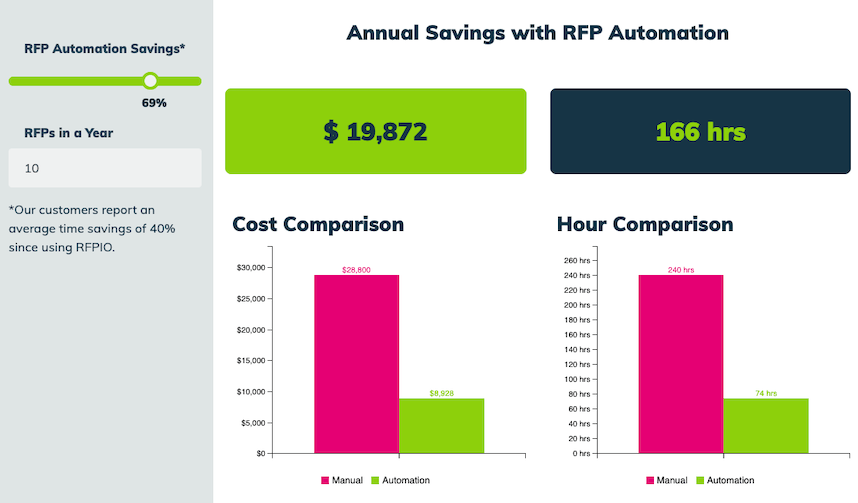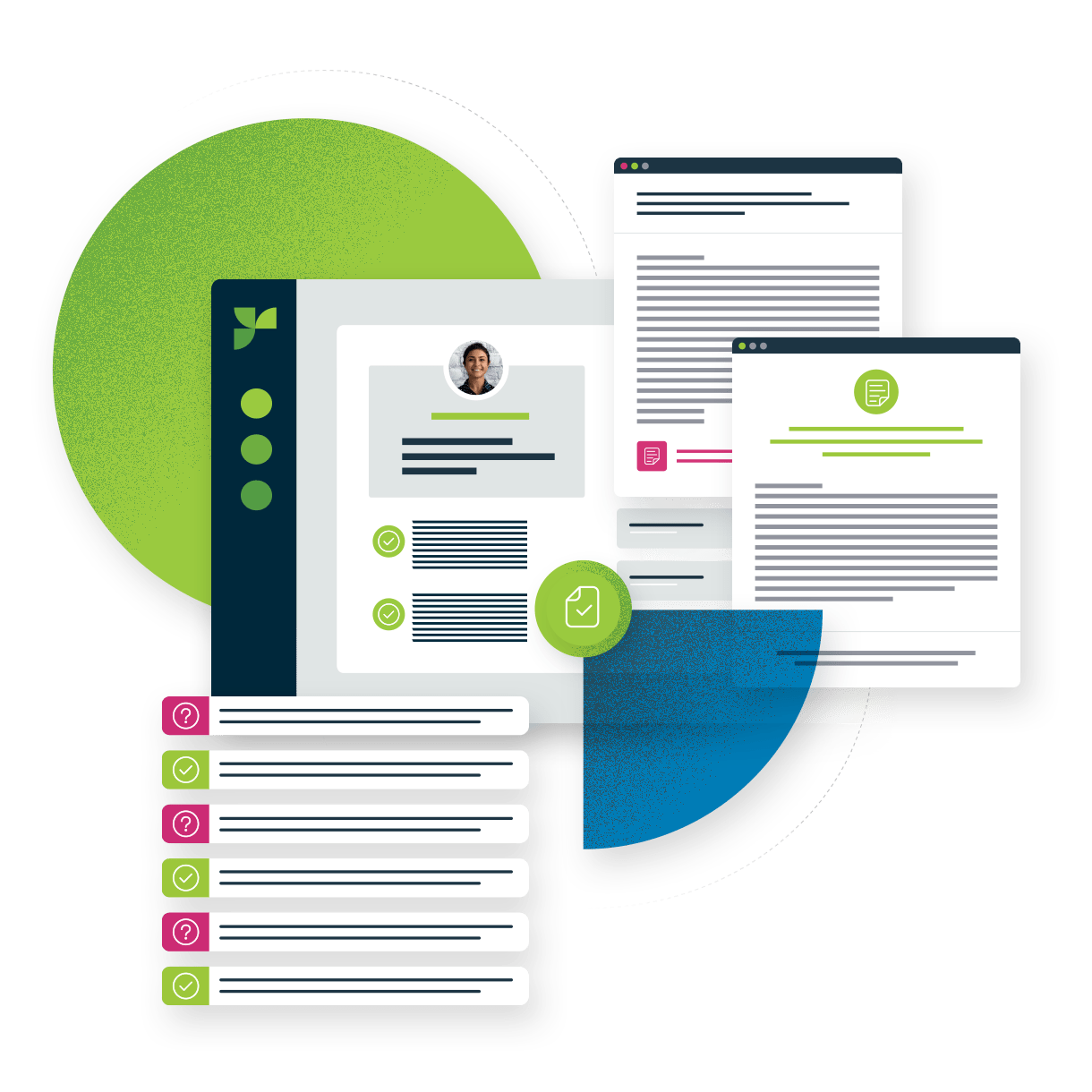Let insights drive your decisions
Decide whether to respond to each RFP and RFI that comes in using built-in intelligence, keeping your team focused on the opportunities you’re most likely to win.
Add the leading RFP software to your sales technology stack, empowering your response team to develop proposals, manage content, simplify project tasks and collaborate in a fraction of the time using intelligent, AI-driven features.




































Manually responding to RFPs is a broken process. Advancements in cloud computing and digitization have raised expectations for issuers. RFPs will continue to grow in size and complexity, because issuers expect vendors to be able to access all of their company and product information. There will be more questions about solution fit as well as more emphasis on security, privacy and compliance.
RFP software from Responsive not only streamlines and automates many of your existing RFP response processes, it revolutionizes how you manage projects, govern content and leverage data to pursue only the RFPs that you can win. You’ll work faster, with greater accuracy, so that you have more time to improve every response.
Built-in intelligence helps you choose the most promising RFPs and RFI. Automated formatting, branding, and drafting.
Find answers to tough questions with an AI-enabled recommendation engine that scours through your company’s content in seconds.
Responsive integrates with CRMs, cloud storage solutions, Microsoft Office, productivity tools, sales enablement applications, and more.
Enhance your answers with tables, images and rich text — and export your RFPs into the source file, or your own branded template.

Decide whether to respond to each RFP and RFI that comes in using built-in intelligence, keeping your team focused on the opportunities you’re most likely to win.
From automated formatting and branding at intake to building up to 80 percent or more of a first draft automatically, Responsive helps you do more, faster.
Responsive integrates with CRMs, cloud storage solutions, Microsoft Office, productivity tools, sales enablement applications and more.
Find answers to tough questions with an AI-enabled recommendation engine that scours through your company’s content in seconds.
Quickly bring in RFPs or other requests directly into the Responsive platform, where you can easily develop responses, collaborate and communicate.
Enhance your answers with tables, images and rich text — and export your RFPs into the source file, or your own branded template.
Organizations that use RFP software respond to more RFPs every year than their counterparts, but they also rely on Responsive RFP software for so many other reasons.

IBA increased win rate by 15% by improving response and bid quality
Responsive saved Microsoft $4.2M by streamlining their RFX processes
How Genpact transformed proposal quality with an access-anywhere knowledge base
How GEODIS cuts SME review effort by 80% with strategic response management software
Reducing RFX response time for a health insurance company from days to hours
Users from across your company can access Responsive through more than two dozen applications you already use, including:
CRMs – Access the Responsive content library through your company’s chosen CRM, including Salesforce, Pipedrive, Dynamics 365, PipelineDeals, and HubSpot.
Communication apps – Responsive enables company-wide collaboration through your existing communication apps, including Slack, Google Hangouts, Jira, and Microsoft Teams.
Cloud storage apps – Seamlessly integrate Responsive with Sharepoint, Box, Dropbox, Google Drive, and OneDrive.
SSO authentication apps – Work within your company’s security protocols through SSO authentication integrations with Microsoft ADFS, Microsoft Azure, OneLogin, and Okta.
Browser extensions – Access the content library through Responsive® LookUp and Chrome.
Vendor assessment apps – Securely import directly from third-party platforms using Whistic.
Productivity apps – Work faster using Responsive with Microsoft Suites and Google Sheets.
Sales enablement apps – Revenue-generating employees can access Responsive through Seismic or Highspot.

Responsive goes beyond simple automation. We use machine learning to intelligently assist you through every step of the RFP response process.
Leverage Responsive to:
Disjointed content is one of the top challenges of an RFP process. The Responsive content library not only simplifies the search but also does much of the work for you.
The content library in Responsive Content:
A request for proposal (RFP) is a document that a buyer issues to suppliers that outlines the product or service requirements for procurement. RFPs come in a variety of different formats and narratives (similar to essay questions).
An RFP is the highest form of communication in the procurement process. Most deals are for more than $20,000—often significantly more, like with extra zeros and another comma. They are most common in government, software, insurance, business services, healthcare, and other complex, highly-regulated industries.
Security questionnaires determine whether a vendor (or even the vendor’s vendors) is compliant with the customer’s security requirements. They may include questions about security and privacy, business continuity management, supply chain management, business continuity management, etc. Not surprisingly, security questionnaires are lengthy and complicated, sometimes with hundreds of questions.
Additionally, there are requests for quotes (RFQ)—typically for purchasing goods rather than services—and requests for information (RFI). RFQs, as you might imagine, are about the bottom line, which makes sense when purchasing several gross of industrial screws, but not services that require a more bespoke approach. On the other hand, an RFI might be used to narrow potential suppliers down for future RFP solicitations.
Of course, RFPs often include RFQs, security questionnaires, and RFIs.
The main objective of an RFP is for organizations to formally announce that they are opening a project for bids. RFPs are more formal and exacting than simple requests for pricing, and they’re typically for larger purchases.
An RFP will describe the needs and expectations of the issuer’s project and create the parameters to compare solutions.
RFPs generally require specific information about regulatory compliance, security, etc. In fact, it helps to think of an RFP response as the precursor to a sales contract and something that would even pass muster with legal departments—and quite often, legal has to approve responses before they’re sent to the customer.
RFPs ask for accurate, compliant, contract-ready answers to customer questions. Compare it to purchasing a house. You might want to know the current state of water or electrical systems, and as part of the presales contract process, the homeowner has to submit the answers in writing. The seller is then legally bound to the accuracy of their answers.
The RFP response is more complex than the uninitiated might think, which is why manual processes only allow for a couple of responses per year. There are a few notable challenges in the RFP response process, including:
Overwhelming volume of both siloed and scattered information – Single RFPs often include hundreds of pages, requiring input from multiple stakeholders. Imagine answering dozens of RFPs per year when you use manual processes!
Content quality – You have one shot at answering an RFP correctly. Content should be centralized, current, and accurate, which requires advanced cataloging.
Everybody and yet nobody’s job at the same time – If an answer isn’t in your content library, the RFP will require collaboration, which means consulting with subject matter experts (SMEs). Having multiple people provide different answers is like herding cats, and extremely difficult without response management.
Behind before you’ve even started – RFP deadlines are firm and many responses are time stamped. Missing a deadline by just a few seconds can rule your company out. Response management should keep you on track throughout the response process.
Stakes are high with significant revenue, legal and brand implications – RFPs require impeccably detailed and accurate answers using existing knowledge and collaboration from SMEs. An RFP response process should ensure consistent and on-time deliverables.
There are three levels of RFP software. The first, manual processes, include some software, such as documents, spreadsheets, and a folder tree, but little else. Manual processes are generally acceptable for companies that only respond to a couple of RFPs a year.
I typically refer to the next level of RFP software as “the document suites.” This includes word-processing software composed of essential collaboration tools, content management, templates, and formatting. Document suites are suitable for companies that answer a handful of RFPs each year.
When RFP-based deals are an essential source of revenue, most organizations opt for the third level—a Response Management solution. These solutions help businesses with responses ranging from RFPs to security questionnaires, and offer the most advanced functionality for creating RFPs and managing their workflows. They save time, money, and costly errors through machine learning, robust integrations, and comprehensive and intuitive content management tools.
Optimized workflow
Responsive optimizes workflow by smoothing out the content creation process, establishing workflow roles, providing selective collaboration, curating and cultivating your content library, and letting you spend more time on presentations instead of herding cats.
With Responsive software, users can rename and customize fields and intake forms, and customize frameworks and business processes. Responsive software is a tool that fits with your processes instead of the other way around. In fact, the Responsive product integrates with more workflow tools than any other response management platform.
Unified collaboration
The response process can include dozens of stakeholders from multiple departments and time zones. Timely collaboration can be a challenge, but not with Responsive. The Responsive product integrates with most project management and messaging apps, and collaboration is built into the platform.
The Responsive platform collaborative tools allow you to:
Improved win rates
The average RFP win rate is 45%. Advanced response software uses AI to streamline the response process, which means you have more time to respond to more RFPs and win more bids. Additionally, the Responsive Content Library helps improve response quality by suggesting pre-approved answers to most queries, leading to an increased win rate.
Even if your win rate has only nominal gains, you will still produce more revenue because, as with many other things, RFP response is a numbers game. If you have the time to respond to more RFPs, you will have more victories and drive revenue.
“Since implementing Responsive, we’ve been able to do so much more with the same headcount. We’ve increased efficiency by at least 30-35%. We’ve diverted the effort and time to more value-added activities, creating a win-win both for the organization and the team members”.
–Shashi K, Assistant VP of Content at Genpact
The Responsive product’s project management features help expedite response turnaround time, scale response capacity, and facilitate consistent deliverables.
Proprietary import and export technology
Most RFPs show up in your inbox as Word or Excel docs. Some appear as PDFs, which less advanced RFP response platforms can’t read. Responsive simplifies the import/export process, even with PDFs, thereby shortening the response time and delivering accurate, timely, and impressive bids. The industry-leading import/export features include:
Adaptive knowledge library
The most time-consuming part of the response process isn’t strategizing. It isn’t even herding those metaphorical cats. Most of an RFP’s questions have probably been answered before, whether for that customer or others—sometimes several others. Answering those redundant questions is where the bulk of response time lies.
The AI-enhanced Content Library expedites the response process by automatically providing pre-approved answers to those tedious questions with just a few keystrokes. The web-based Content Library includes:
Built-in integrations
Responsive is scalable and seamlessly integrates with over two dozen of the most popular sales enablement tools, productivity apps, CRMs, cloud storage providers, communication platforms, and SSO authentication software products.
Robust project management tools
The Responsive management solution alleviates common challenges in meeting deadlines with better workflow assessment, even with distributed workforces. Responsive Project management capabilities include:
See why leading response teams trust Responsive for their RFP response management.
Schedule a customized demo to see why 250,000+ users at the world’s top organizations trust Responsive.
This website uses cookies so that we can provide you with the best user experience possible. Cookie information is stored in your browser and performs functions such as recognising you when you return to our website and helping our team to understand which sections of the website you find most interesting and useful.
To learn more read our Cookie Policy.
Strictly Necessary Cookie should be enabled at all times so that we can save your preferences for cookie settings.
We use cookies to enhance your browsing experience, serve personalized ads or content, and analyze our traffic. By choosing to leave these enabled, you consent to our use of cookies.
Please enable Strictly Necessary Cookies first so that we can save your preferences!